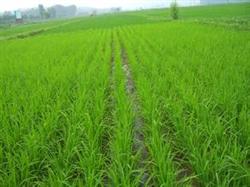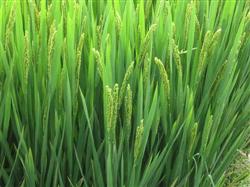Summary on High-yield cultivation techniques of dry cultivation and late planting of Rice

The technology of dry raising rice seedlings has been introduced into Luoquan Town since 1990s. After the stage of experiment, demonstration and extension, through nearly 20 years of production practice, many successful experiences have been obtained from sowing experiments in different soils and different ways. now dry seedling raising technology is a mature new rice seedling raising technology in our town. After repeated experiments and comparison, the acid yellow sandy land is selected as the most suitable soil quality for dry seedling raising, and where there is this kind of soil quality, it is suitable for large area popularization. in the rice producing areas in Luoquan, the water source conditions are relatively poor, and it is difficult to use water to raise seedlings in most years. The field can not guarantee that it can be planted on time, and the promotion of dry rice seedlings is the best choice. At the same time of the popularization of dry seedling raising technology in our town, its yield increasing effect has also been well reflected. In the transplanting field of dry raising seedling, no matter in dam land, hilly or mountainous area, dry raising seedling grows rapidly after transplanting. The stem is thick and strong, the spike is big and grains are many, and the seed setting rate is high, which can increase the yield by more than 50 kilograms per mu, which is obviously increased and is welcomed by farmers. However, another outstanding performance of dry raising seedlings is little known. That is, late planting, which is not available in paddy fields, can also achieve high yield. It is a new technology that I fumbled out in production practice. The drought was severe in the first half of 2007, and there was almost no rain in May, making it impossible for many rice fields to plant seedlings. It only rained heavily in June (the second day of the fifth lunar month), but the rice planting season has long been missed. The seedlings planted in the current season have been planted for more than 50 days, and the jointing period is coming to an end. The seedling age has reached more than 80 days, and the seedlings that have not been transplanted in the paddy field are still growing. because there is already booting in the main ear, and then transplanted to Honda, there will be secondary heading, and the yield is low, which is of little significance. However, due to the lack of water for a long time and countless times of withering, the seedlings basically stopped growing, showing that the plants were short, and there were two upper nodes in the main stem and Dafen, but there was no booting phenomenon. According to intuition, it is still worth transplanting. On the fourth day of the fifth lunar month (the day before the Dragon Boat Festival), on the basis of one-time application of sufficient fertilizer in the whole field, people were asked to transplant 4 mu of medium seedlings into fields of less than two mu, with no less than 12 basic seedlings per litter and a row spacing of 8 inches × 8 inches. Observation three days after transplanting, the seedlings have grown a centimeter of new roots, and more stout, there is no return to green period, 7 days later began to tiller, growing rapidly. After transplanting for 20 days, the whole field was basically closed, and the growth potential was still prosperous. Rice thrips and other pests occurred and were controlled once in the whole field, and tricyclazole was added to prevent leaf rice blast. One month after transplanting, the seedling field entered the jointing and booting stage one after another, the main stem did not appear the phenomenon of heading first, and the growth was basically the same. In the early stage of jointing, due to excessive growth, the whole field cut leaves once, cutting off nearly 1/3 of the upper leaves. Control the growing seedlings, develop normally, and apply pesticide to control borer and other pests at the early booting stage. At the heading stage 47 days after transplanting, rice bugs (fart beetles) were controlled and tricyclazole was applied to prevent panicle neck blast. Grain fertilizer was not applied because of sufficient fertilizer and water. 95 days after transplanting (the 10th day of August of the lunar calendar), the grain reached 90% yellow, please harvest, and all overweighed, converted into a measured area, the yield per mu can reach more than 830 jin, only less than 100 jin lower than that of the main season, the effect is satisfactory. The summary of the experiment: throughout its whole growing period, it is in the middle of summer and there is plenty of fertilizer and water. In addition, due to the transplanting of drought-raised seedlings into the paddy field, various physiological functions have been reactivated, growing rapidly, and each development period has been advanced in order to achieve super-normal growth and high yield. through the experiment, it is concluded that the high-yield cultivation techniques of dry breeding and late planting are as follows: 1. The variety is Chuanxiangyou 2, and the growth period is obviously longer than that of Gangyou series for more than 7 days. Therefore, late planting should choose varieties with longer growth period, strong growth, resistance to fertilizer and water, resistance to lodging and high resistance to rice blast (leaf blast is easy to occur due to high temperature and high humidity in midsummer). 2. Dry cultivation and sparse planting to protect basic seedlings: dry cultivation is the key factor to ensure late planting and high yield. When raising seedlings in paddy field, even if the surface of the field is cracked, it can not stop its growth and development. when the seedling age reaches more than 75 days, it is bound to produce secondary heading, harvest trouble, poor ontogeny and low yield. When the drought is serious, the growth of dry seedling is slow to stop growing, the seedling age is elastic, it is not easy to aging, and it has the explosive force of rapid growth after entering the water, but paddy field seedling raising does not have this function, which is also the biggest advantage of dry seedling raising. Each growth stage can promote early maturity in advance, therefore, it can only be planted in drought in the place where planting in the right season can not be guaranteed, sowing should increase seeds by more than 50%, and sparsely sow and remove weeds to ensure the basic seedlings of late-planted fields. 3. Applying base fertilizer and topdressing at the same time, cutting leaves to control overgrowth. The growth period of late planting field is very short, so it is necessary to apply enough nitrogen, phosphorus and potassium fertilizer at one time, nitrogen fertilizer is a little heavier, tillering is accelerated, and high quality compound fertilizer plus urea should be selected. This is especially true for paddy fields with poor soil quality. The field with excessive fertilizer can be cut once to control the growth at the early stage of jointing. Cutting leaves and controlling length is a necessary technique for late planting. Unless you are absolutely sure to control the amount of fertilizer applied. Leaf cutting should be in the late tillering stage to the middle jointing stage, and at the latest in the early booting stage, too late cutting leaves will affect the yield, and about 1/4 of the top leaves can be cut off in the whole field, so as to reduce shade and enhance photosynthesis. Reduce the incidence of diseases and insect pests. 4. pay close attention to the prevention and control of diseases and insect pests: due to sufficient water and fertilizer, green seedlings, rice thrips, borers and planthoppers, the prevention and control of fart insects must be strengthened, otherwise there is no hope of high yield. in addition, attention should be paid to the prevention and control of rice blast and sheath blight. If leaf blast occurs, about 1/3 of the leaves will be cut and applied immediately.
- Prev

Cultivation techniques of dry cultivation and dry cultivation of Rice
Dry cultivation means that when the seedling age of early rice is suitable for throwing and planting, under the condition of drought and lack of water in the field, herbicides are directly sprayed to control weeds, and then holes are burrowed with wooden sticks or ditches are opened with shovels, and then seedlings are transplanted and planted. Key points of cultivation techniques (1) Paddy field treatment: spraying herbicides before planting is optional.
- Next

What is the law of fertilizer requirement in each growth stage of rice?
The law of nitrogen absorption: sleeping until sleep is very sensitive to nitrogen nutrition, which is the most important factor to determine the quality of rice. Rice has a high nitrogen concentration in its whole life, which is the nutritional and physiological characteristics needed for high-yield rice. There are two obvious peaks of nitrogen uptake by rice. One is the tillering stage, that is, 2 weeks after transplanting.
Related
- The first cup of black tea in spring, the flavor and history of tea gardens in Kenya, Africa
- The computer can not only choose potatoes, but also grow tea rice. AI will grow winter oolong tea champion.
- It is not only the inflated tea bitten by insects, but also engraved with the four seasons tea in Beipu.
- The Oriental Beauty Tea Festival in Zhuxian County takes the stage at the weekend to experience the plus-size feast of oil tea.
- & quot; Oriental Beauty Tea & Exploration of Emei in Hsinchu, the hometown of quot;
- The new variety of strawberry "Tainong 1" dessert is the first choice with mellow aroma. Crimson gorgeous
- History of Tea in Taiwan: from Wild Inner Mountain to Export Tea Garden
- Two types of Taiwan Oriental Beauty Black Tea won the British three-Star Award for Childhood Tea Xiang Zhang Jiaqi changed from pilot to champion tea maker.
- Banana species and varieties: the planting history of Taiwan Xianren banana and dwarf banana is long, is banana disease resistant?
- Coffee planting Technology: Qianjie Coffee from Seedling to harvesting

